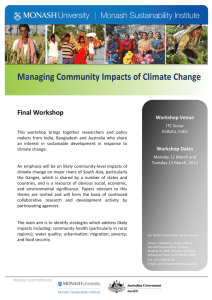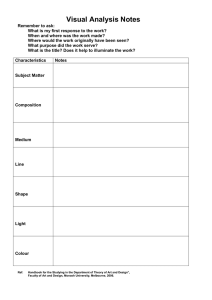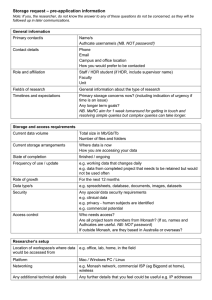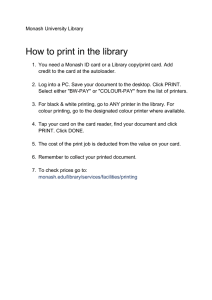MONASH U
advertisement
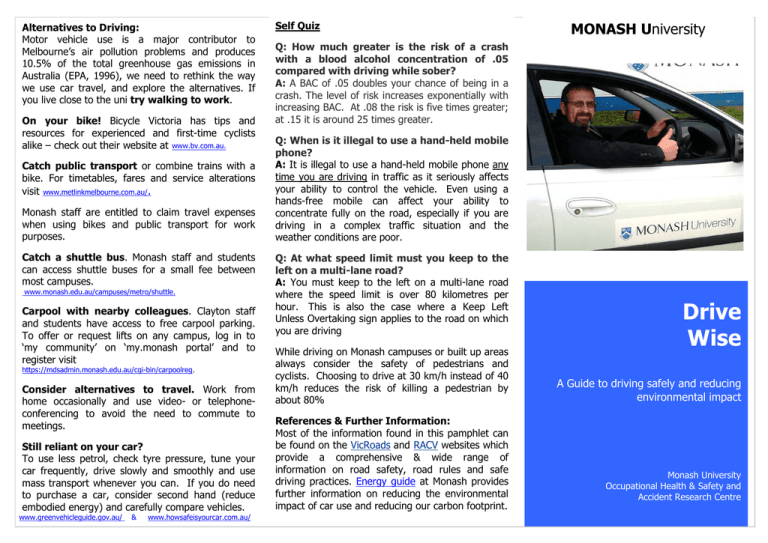
Alternatives to Driving: Motor vehicle use is a major contributor to Melbourne’s air pollution problems and produces 10.5% of the total greenhouse gas emissions in Australia (EPA, 1996), we need to rethink the way we use car travel, and explore the alternatives. If you live close to the uni try walking to work. On your bike! Bicycle Victoria has tips and resources for experienced and first-time cyclists alike – check out their website at www.bv.com.au. Catch public transport or combine trains with a bike. For timetables, fares and service alterations visit www.metlinkmelbourne.com.au/. Monash staff are entitled to claim travel expenses when using bikes and public transport for work purposes. Catch a shuttle bus. Monash staff and students can access shuttle buses for a small fee between most campuses. www.monash.edu.au/campuses/metro/shuttle. Carpool with nearby colleagues. Clayton staff and students have access to free carpool parking. To offer or request lifts on any campus, log in to ‘my community’ on ‘my.monash portal’ and to register visit https://mdsadmin.monash.edu.au/cgi-bin/carpoolreg. Consider alternatives to travel. Work from home occasionally and use video- or telephoneconferencing to avoid the need to commute to meetings. Still reliant on your car? To use less petrol, check tyre pressure, tune your car frequently, drive slowly and smoothly and use mass transport whenever you can. If you do need to purchase a car, consider second hand (reduce embodied energy) and carefully compare vehicles. www.greenvehicleguide.gov.au/ & www.howsafeisyourcar.com.au/ Self Quiz MONASH University Q: How much greater is the risk of a crash with a blood alcohol concentration of .05 compared with driving while sober? A: A BAC of .05 doubles your chance of being in a crash. The level of risk increases exponentially with increasing BAC. At .08 the risk is five times greater; at .15 it is around 25 times greater. Q: When is it illegal to use a hand-held mobile phone? A: It is illegal to use a hand-held mobile phone any time you are driving in traffic as it seriously affects your ability to control the vehicle. Even using a hands-free mobile can affect your ability to concentrate fully on the road, especially if you are driving in a complex traffic situation and the weather conditions are poor. Q: At what speed limit must you keep to the left on a multi-lane road? A: You must keep to the left on a multi-lane road where the speed limit is over 80 kilometres per hour. This is also the case where a Keep Left Unless Overtaking sign applies to the road on which you are driving While driving on Monash campuses or built up areas always consider the safety of pedestrians and cyclists. Choosing to drive at 30 km/h instead of 40 km/h reduces the risk of killing a pedestrian by about 80% References & Further Information: Most of the information found in this pamphlet can be found on the VicRoads and RACV websites which provide a comprehensive & wide range of information on road safety, road rules and safe driving practices. Energy guide at Monash provides further information on reducing the environmental impact of car use and reducing our carbon footprint. Drive Wise A Guide to driving safely and reducing environmental impact Monash University Occupational Health & Safety and Accident Research Centre Background Road crashes are the most common form of work-related fatalities, injuries and absence from work in Australia. Monash University has a ‘duty of care’ as an employer to ensure the safety of their staff on the roads if their job requires any driving. Monash has an obligation to make sure company vehicles are in a sound condition and ensure that employees using them have the necessary skills and training. Monash is also committed to reducing its environmental impact. Statistics Many fatalities and serious injuries occur on Victorian Roads each year. This results in a horrific human cost through death, pain and suffering of those affected, their families and also a significant financial cost to society. Fatalities (equivalent periods) 2001 2002 2003 2004 2005 5 year average 444 397 330 343 346 372 Serious injuries (equivalent periods) 2001 2002 2003 2004 2005 5 year average 6371 6683 6924 6683 6379 6608 Plan Your Trip: As with most safety issues a little forward thinking and planning goes a long way. Firstly is there an alternative to travelling such as video conferencing? If not, allow extra time for travel in peak hour, built up areas or if you are driving in a new region. Look at a map and find the best route, consider the weather conditions and plan breaks if travelling a significant distance, consider driver rotation if travelling in a group over a long distance. The Importance of Speed Choice In city and urban environments, the volume, mix and unexpected behaviour of traffic places many demands on a driver. Issues such as obscured signage, new intersections or road works can be confusing. In these situations choosing the right speed for the environment and self control is needed to remain calm even when provoked. Staying aware of conditions is essential for safe driving; this involves knowing what is going on ahead, to the sides and behind your vehicle. Look ahead at the traffic scene, be prepared for the unexpected and anticipate what other road users might do. Develop an attitude that makes allowance for others when they make mistakes; cooperation with all other road users goes a long way towards greater enjoyment and much safer driving even in difficult situations. Fatigue Around 20% of fatal road accidents involve driver fatigue. According to VicRoads about 30% of severe single vehicle crashes in rural areas involve the driver being fatigued. The Adelaide Centre for Sleep Research concluded that a person who has been awake for 17 hours faces the equivalent risk of having an accident as a Blood Alcohol Content (BAC) reading of 0.05, and is therefore twice as likely to have an accident as a person who is not fatigued. Drivers who have been awake for 24 hours have an equivalent driving performance to a person who has a BAC of 0.1, and is seven times more likely to have an accident. Weather Conditions Driving in harsh conditions such as rain, fog, snow and bright sunlight calls for extra care and can be much more stressful than driving in normal conditions. These factors reduce visibility, extend stopping distances, increase the risk of skidding and losing control, and can make overtaking extremely dangerous Mobile Phones It is illegal to drive and talk on a hand held mobile phone, Monash also discourages the use of hands free units whilst driving as this has the equivalent risk of driving at a BAC of 0.05. Key Safety Tips • Leave at least a two second gap (even more for trucks) between the cars ahead and your own, allow a four second gap in wet weather, at night, when towing, and when you are unfamiliar with the road. • Using headlights even during the day makes it easier for your car to be seen by pedestrians, cyclists and other drivers. • It is important to turn your head to check for vehicles and bikes in your blind spot, especially when merging, changing lanes or before moving off at an intersection. Try turning from the waist to make this easier. • It is easy to feel pressured to increase speed if there is a line of traffic behind you, or a car tailgating. Pull off the road to let them pass if you need to. • Anticipate what might happen by looking ahead and closely observing the movement of other traffic wherever you drive. • Expect the unexpected in city driving; take extra care when changing lanes, overtaking, going through intersections & driving at night. • Take a powernap whenever you feel drowsy. • When driving conditions become difficult or extreme through rain, fog, snow or glare reduce your speed accordingly. Some of the reasons given for the higher incidence of crashes involving company cars are that their drivers generally drive further and are often under time pressures caused by tight schedules. Because the drivers don’t own the cars they drive, they also tend to be less concerned about damage and wear and tear.

